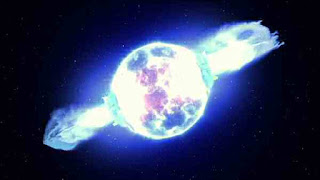Evolution speeds up with cosmic activity.
Most people assume that we are isolated here on this tiny planet called Earth. However, throughout the ages life has been impacted by what goes on out there in the cosmos. Humans would not be dominant in the world today - considering we got down to less than a hundred souls when the climate suddenly took a new direction.
 |
| An arrow piercing a supernova? |
When astrophysical phenomena such as black holes send out x-ray flares it affects earthly evolution. It has estimated by computer modelling that two supernovas occurring close together increased radiation on marine life by a factor of three. This is a major change that nascent intelligent life had to adapt to.
Radiation sends out muon particles which hit the ground. More of them alters the environment. DNA mutation will speed up, so evolution becomes more rapid. This would account for the sudden disappearance of established species and takeover by new ones.
The dark clouded lightning nights portrayed in Frankenstein movies would not be far from the truth. Increased radiation would raise ionization of the atmosphere. Thus, the frequency of lightning strikes
would intensify.
◆ Cosmology by Ty Buchanan ◆
●
cosmology, universe, cosmos, planet, earth, evolution, supernova, black hole, life, marine, dna articles news politics economics society anthropology historiography history sociology people nations country asia europe africa u.s. south america central Mediterranean eastern western interesting amusing technology free news sex



